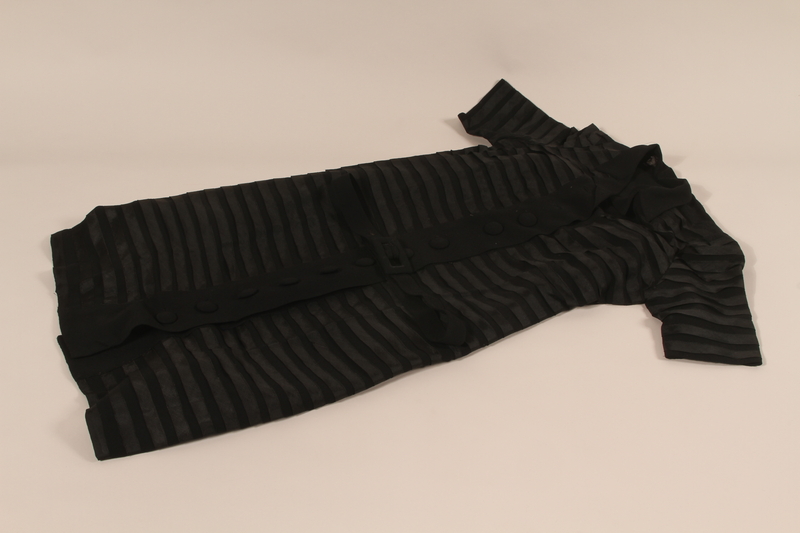Overview
- Brief Narrative
- Handmade coatdress and belt designed and created by Gertrud Koh Isaacsohn, a Jewish dressmaker in prewar Berlin, Germany. In 1938, Gertrud and her husband Julius, a coat and suit designer with his own garment making business, had lost their livelihood because of the anti-Semitic policies of the Nazi regime. They sent their daughter Dorit, age 6, to Brussels, Belgium, in early 1939, to stay with Gertrud’s sister Anna Kaufman. Germany invaded Belgium in May 1940, and Gertrud and Julius had Dorit returned to them in 1941. Gertrud and Julius became forced laborers for the German government, working in a leather factory and lumber yard respectively. On February 27, 1943, the family had to separate in order to go into hiding. Gertrud began working as a traveling seamstress and Julius and Dorit stayed with family friends, and Julius’ nephew, Rolf Isaacsohn, in Berlin. In October 1943, Gertrud brought Dorit to live with her on a farm in Wilkersdorf. Shortly after, Julius, who was hiding with friends, was betrayed to the authorities by Rolf. On October 29, Julius was deported to Auschwitz-Birkenau killing center in German-occupied Poland, where he was killed. Gertrud and Dorit traveled around eastern Germany making dresses for private clients until January 1945, when they were liberated by Soviet forces in Wilkersdorf. Gertrud and Dorit immigrated to the United States in November 1949.
- Date
-
creation:
approximately 1938
- Geography
-
creation:
Berlin (Germany)
- Credit Line
- United States Holocaust Memorial Museum Collection, Gift of Dorit Isaacsohn
- Contributor
-
Subject:
Gertrud Isaacsohn
Designer: Gertrud Isaacsohn
- Biography
-
Gertrud Koh was born on June 3, 1901, in Gratz, Germany (Grodzisk Wielkopolski, Poland), to Alex and Dorothea Koh. She had two brothers and a sister. Following the end of World War I, Gertrud’s family moved to Berlin, Germany. As a young woman, she learned to sew and with additional training became a master seamstress. In May 1931, Gertrud married Julius Isaacsohn, a Berlin native. He was born on November 19, 1891, to Herrman Benjamin and Ernestine Kaiser Isaacsohn, and had several brothers. Julius was a garment maker and coat and suit designer who imported fabric. On July 15, 1933, Gertrud and Julius’ daughter, Dorothea (Dorit,) was born. Gertrud ran a dressmaking business in their apartment and employed a non-Jewish woman, Lucie Gardner. They made a good living, lived in a predominantly Jewish area, and attended a large synagogue.
The Nazi regime took power in 1933, and began actively persecuting Jews. Gertrud’s employee Lucie was not allowed to work for a Jewish woman. In 1938, Julius and Gertrud lost their jobs. In early 1939, they attempted to leave Germany, but could not get visas. They sent 6 year old Dorit to Brussels, Belgium, to live with Gertrud’s sister, Anna Kaufman. She, her husband, and stepson had fled to Brussels earlier because Anna’s stepson was gay and was persecuted by the Nazis. Gertrud’s brother Ludwig also lived in Brussels. Dorit had diphtheria when she arrived and was hospitalized, before going to live with her aunt Anna. Gertrud and Julius were forced to house displaced Jewish families in their apartment. The war began when Germany invaded Poland on September 1, 1939. Shortly after, on May 10, 1940, Germany invaded Belgium. A year later, Gertrud and Julius had Dorit returned to Berlin with the help of a family friend. Gertrud and Julius became forced laborers for the German government: Gertrud at a Kurt Seidel factory sewing leather army goods, and Julius at a lumber yard.
On February 27, 1943, Gertrud heard that there was going to be a large roundup of Jews and the family went into hiding with non-Jewish friends. Gertrud and Julius found an apartment to rent under the false name Schultz, but they had no papers to support that claim. When they arrived, the owner refused to let them stay and they separated. Gertrud sent Dorit to stay with her former employee, Lucie Gardner. Gertrud put an ad in the paper advertising herself as a private, traveling dressmaker who had been bombed out of her apartment and was looking for work in people’s homes. She told people that her husband was in the army and her daughter was with family. Julius went to stay in the basement apartment of a janitor, where he slept in a rocking chair. In April or May, Dorit moved into a crowded apartment with her cousin Rolf Isaacsohn, and his girlfriend, Stella Goldschlag Kubler. In July, Rolf and Dorit learned that Stella had been arrested by the Gestapo. Shortly after, Dorit went to live with Julius in the janitor’s apartment.
In October 1943, Gertrud was living at a farm in Wilkersdorf (Krzesnica, Poland) and asked the farmer to allow Dorit to live there. The farmer agreed if Dorit brought stamps for sugar. Julius purchased the stamps on the black market and Dorit moved to the farm. Gertrud sent Julius a package for his birthday in November, but did not receive a response. When they returned to Berlin for another job, they were told that Julius’ nephew Rolf now worked for the Gestapo and had betrayed Julius, who had been arrested. Gertrud and Dorit traveled around Germany working for different clients, including farmers, a judge, and the head of the Gestapo. In December 1944, they returned to Wilkersdorf to make a wedding dress. In early January 1945, Soviet forces liberated the town. Gertrud was raped by the soldiers. The Soviets demanded that Germans march eastward, so Gertrud and Dorit walked for days, taking food from empty houses. The war ended when Germany surrendered on May 7, 1945.
Gertrud and Dorit were forced to leave, as the area they were staying in was now Poland. While walking back to Berlin, they were unable to bathe and Dorit got lice and was covered in contagious sores. They arrived in July and resumed using the last name Isaacsohn. Gertrud registered with the Jewish community, but found no relatives on the survivors list. Gertrud was placed in a displaced persons camp, and Dorit was put in the Jewish hospital because of the sores. Later, Gertrud learned that on October 29, 1943, Julius had been sent to Auschwitz-Birkenau killing center in German-occupied Poland, on transport 45, and was killed. Gertrud’s brother Ludwig survived several concentration camps, but the rest of their family perished. In late 1945, Dorit was sent to Lüneburg, Germany, because Gertrud was sick. In summer 1946, she returned to Gertrud, who was healthy and had an apartment and a job as a dressmaker. Gertrud learned that during the war, Rolf had tried to turn them over to the Gestapo, but could not find them. He escaped after the war, and left his wife Stella to be captured and tried as a collaborator by the Soviets. On October 25, 1949, Gertrud and Dorit immigrated to the United States on the USAT General Ballou. They settled in Easton, Pennsylvania. Sixteen year old Dorit changed her name to Dorothy, but continued to go by Dorit. Dorit went to hairdressing school and worked as a hairdresser, while Gertrud worked in a clothing factory and did alterations in a men’s clothing store. In 1952, they moved to Philadelphia. Gertrud, 77, died in July 1978, in Philadelphia. Dorit, 75, died on December 5, 2008.
Physical Details
- Classification
-
Clothing and Dress
- Category
-
Women's clothing
- Object Type
-
Coatdresses (lcsh)
- Genre/Form
- Dressmaking. Women's clothing. Coatdresses.
- Physical Description
- a. Short sleeved, knee-length, textured black cloth coatdress with a notched collar, decorated with evenly spaced, ¾ inch wide strips of thick, black woven cloth horizontally sewn to the body and sleeves. On the front, running the full length of the dress, is a reinforced, 11 button placket with large, round, cloth covered, metal shank buttons sewn along the left side, 12 finished buttonholes on the right, and a black painted metal snap sewn at the waistline. The shoulders are padded, and the cloth is neatly pleated along the defined shoulder seams. At the waist, a string loop for a belt (b) is sewn into each side seam, which tapers in before flaring out slightly at the hips. The coatdress is fitted and neatly tailored with finished hems, contouring darts along the bust and waist, and raw edged seams inside. On the interior, thick, curved pads of satiny, black cloth are sewn into the shoulders, and semi-circular, discolored, dark blue pads filled with crinkly material are sewn into the armpits. The coatdress has been altered in several places, and there are small snags in the material from use.
b. Light weight, textured black cloth belt for a woman’s coatdress (a) with a cloth covered, slightly arched, rectangular cardboard buckle and a black painted metal snap socket sewn beside it at one end. The corresponding snap stud is sewn to the underside of the opposite tapered, rounded end. The belt has a neatly hemmed edge with some loose threads and wear along the inner buckle. - Dimensions
- a: Height: 41.000 inches (104.14 cm) | Width: 13.250 inches (33.655 cm)
b: Height: 38.000 inches (96.52 cm) | Width: 1.250 inches (3.175 cm) - Materials
- a : cloth, thread, metal, string, paint
b : cloth, thread, metal, paint, cardboard
Rights & Restrictions
- Conditions on Access
- No restrictions on access
- Conditions on Use
- No restrictions on use
Keywords & Subjects
- Topical Term
- Fashion designers--Germany--Berlin--Biography. Hidden children (Holocaust)--Germany--Berlin--Biography. Holocaust survivors--United States--Biography. Holocaust, Jewish (1939-1945)--Germany--Berlin--Personal narratives. Jews--Persecution--Germany--Biography. Germany--Emigration and immigration--History--20th century. United States--Emigration and immigration--History--20th century.
- Geographic Name
- Germany. Berlin (Germany) United States. Belgium.
Administrative Notes
- Legal Status
- Permanent Collection
- Provenance
- The coatdress and belt were donated the United States Holocaust Memorial Museum in 2002 by Dorit Isaacsohn, the daughter of Julius and Gertrud Isaacsohn.
- Funding Note
- The cataloging of this artifact has been supported by a grant from the Conference on Jewish Material Claims Against Germany.
- Record last modified:
- 2022-07-28 18:11:42
- This page:
- https://collections.ushmm.org/search/catalog/irn520969
Download & Licensing
In-Person Research
- By Appointment
- Request 21 Days in Advance of Visit
- Plan a Research Visit
- Request to See This Object
Contact Us
Also in Dorit Isaacsohn family collection
The collection consists of fashion drawings, handmade garments, and photographs relating to the experiences of Gertrude, Julius and Dorit Isaacsohn before the Holocaust in Grätz (Grodzisk Wielkopolski, Poland) and Berlin, Germany, and after the Holocaust in Berlin and the United States.
Date: 1930-1949
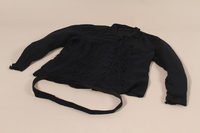
Navy openwork jacket with belt made by a German Jewish woman
Object
Handmade jacket and belt designed and created by Gertrud Koh Isaacsohn, a Jewish dressmaker in prewar Berlin, Germany. In 1938, Gertrud and her husband Julius, a coat and suit designer with his own garment making business, had lost their livelihood because of the anti-Semitic policies of the Nazi regime. They sent their daughter Dorit, age 6, to Brussels, Belgium, in early 1939, to stay with Gertrud’s sister Anna Kaufman. Germany invaded Belgium in May 1940, and Gertrud and Julius had Dorit returned to them in 1941. Gertrud and Julius became forced laborers for the German government, working in a leather factory and lumber yard respectively. On February 27, 1943, the family had to separate in order to go into hiding. Gertrud began working as a traveling seamstress and Julius and Dorit stayed with family friends, and Julius’ nephew, Rolf Isaacsohn, in Berlin. In October 1943, Gertrud brought Dorit to live with her on a farm in Wilkersdorf. Shortly after, Julius, who was hiding with friends, was betrayed to the authorities by Rolf. On October 29, Julius was deported to Auschwitz-Birkenau killing center in German-occupied Poland, where he was killed. Gertrud and Dorit traveled around eastern Germany making dresses for private clients until January 1945, when they were liberated by Soviet forces in Wilkersdorf. Gertrud and Dorit immigrated to the United States in November 1949.
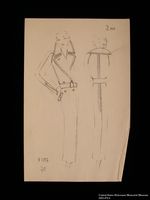
Coat design, Iris, created by a German Jewish man and saved by his wife in hiding
Object
Original design for a coat created by Julius Isaacsohn, a Jewish designer with his own garment making business in prewar Berlin, Germany. In 1938, Julius and his wife Gertrud, a dressmaker with her own business, had lost their livelihood because of the anti-Semitic policies of the Nazi regime. They sent their daughter Dorit, age 6, to Brussels, Belgium, in early 1939, to stay with Gertrud’s sister Anna Kaufman. Germany invaded Belgium in May 1940, and Gertrud and Julius had Dorit returned to them in 1941. Gertrud and Julius became forced laborers for the German government, working in a leather factory and lumber yard respectively. On February 27, 1943, the family had to separate in order to go into hiding. Julius and Dorit stayed with family friends and Julius’ nephew, Rolf Isaacsohn, in Berlin, while Gertrud began working as a traveling seamstress. In October 1943, Gertrud brought Dorit to live with her on a farm in Wilkersdorf. Shortly after, Julius, who was hiding with friends, was betrayed to the authorities by Rolf. On October 29, Julius was deported to Auschwitz-Birkenau killing center in German-occupied Poland, where he was killed. Gertrud and Dorit traveled around eastern Germany making dresses for private clients until January 1945, when they were liberated by Soviet forces in Wilkersdorf. Gertrud and Dorit immigrated to the United States in November 1949.
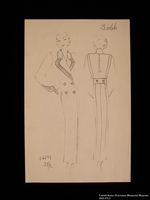
Coat design, Görlik, created by a German Jewish man and saved by his wife in hiding
Object
Original design for a coat created by Julius Isaacsohn, a Jewish designer with his own garment making business in prewar Berlin, Germany. In 1938, Julius and his wife Gertrud, a dressmaker with her own business, had lost their livelihood because of the anti-Semitic policies of the Nazi regime. They sent their daughter Dorit, age 6, to Brussels, Belgium, in early 1939, to stay with Gertrud’s sister Anna Kaufman. Germany invaded Belgium in May 1940, and Gertrud and Julius had Dorit returned to them in 1941. Gertrud and Julius became forced laborers for the German government, working in a leather factory and lumber yard respectively. On February 27, 1943, the family had to separate in order to go into hiding. Julius and Dorit stayed with family friends and Julius’ nephew, Rolf Isaacsohn, in Berlin, while Gertrud began working as a traveling seamstress. In October 1943, Gertrud brought Dorit to live with her on a farm in Wilkersdorf. Shortly after, Julius, who was hiding with friends, was betrayed to the authorities by Rolf. On October 29, Julius was deported to Auschwitz-Birkenau killing center in German-occupied Poland, where he was killed. Gertrud and Dorit traveled around eastern Germany making dresses for private clients until January 1945, when they were liberated by Soviet forces in Wilkersdorf. Gertrud and Dorit immigrated to the United States in November 1949.
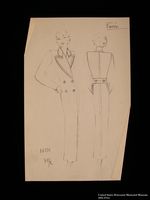
Coat design, Turin, created by a German Jewish man and saved by his wife in hiding
Object
Original design for a coat created by Julius Isaacsohn, a Jewish designer with his own garment making business in prewar Berlin, Germany. In 1938, Julius and his wife Gertrud, a dressmaker with her own business, had lost their livelihood because of the anti-Semitic policies of the Nazi regime. They sent their daughter Dorit, age 6, to Brussels, Belgium, in early 1939, to stay with Gertrud’s sister Anna Kaufman. Germany invaded Belgium in May 1940, and Gertrud and Julius had Dorit returned to them in 1941. Gertrud and Julius became forced laborers for the German government, working in a leather factory and lumber yard respectively. On February 27, 1943, the family had to separate in order to go into hiding. Julius and Dorit stayed with family friends and Julius’ nephew, Rolf Isaacsohn, in Berlin, while Gertrud began working as a traveling seamstress. In October 1943, Gertrud brought Dorit to live with her on a farm in Wilkersdorf. Shortly after, Julius, who was hiding with friends, was betrayed to the authorities by Rolf. On October 29, Julius was deported to Auschwitz-Birkenau killing center in German-occupied Poland, where he was killed. Gertrud and Dorit traveled around eastern Germany making dresses for private clients until January 1945, when they were liberated by Soviet forces in Wilkersdorf. Gertrud and Dorit immigrated to the United States in November 1949.
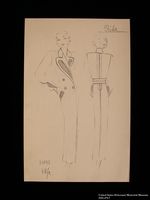
Coat design, Rita, created by a German Jewish man and saved by his wife in hiding
Object
Original design for a coat created by Julius Isaacsohn, a Jewish designer with his own garment making business in prewar Berlin, Germany. In 1938, Julius and his wife Gertrud, a dressmaker with her own business, had lost their livelihood because of the anti-Semitic policies of the Nazi regime. They sent their daughter Dorit, age 6, to Brussels, Belgium, in early 1939, to stay with Gertrud’s sister Anna Kaufman. Germany invaded Belgium in May 1940, and Gertrud and Julius had Dorit returned to them in 1941. Gertrud and Julius became forced laborers for the German government, working in a leather factory and lumber yard respectively. On February 27, 1943, the family had to separate in order to go into hiding. Julius and Dorit stayed with family friends and Julius’ nephew, Rolf Isaacsohn, in Berlin, while Gertrud began working as a traveling seamstress. In October 1943, Gertrud brought Dorit to live with her on a farm in Wilkersdorf. Shortly after, Julius, who was hiding with friends, was betrayed to the authorities by Rolf. On October 29, Julius was deported to Auschwitz-Birkenau killing center in German-occupied Poland, where he was killed. Gertrud and Dorit traveled around eastern Germany making dresses for private clients until January 1945, when they were liberated by Soviet forces in Wilkersdorf. Gertrud and Dorit immigrated to the United States in November 1949.
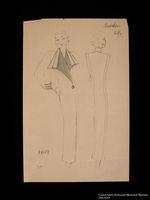
Coat design, Dresden, created by a German Jewish man and saved by his wife in hiding
Object
Original design for a coat created by Julius Isaacsohn, a Jewish designer with his own garment making business in prewar Berlin, Germany. In 1938, Julius and his wife Gertrud, a dressmaker with her own business, had lost their livelihood because of the anti-Semitic policies of the Nazi regime. They sent their daughter Dorit, age 6, to Brussels, Belgium, in early 1939, to stay with Gertrud’s sister Anna Kaufman. Germany invaded Belgium in May 1940, and Gertrud and Julius had Dorit returned to them in 1941. Gertrud and Julius became forced laborers for the German government, working in a leather factory and lumber yard respectively. On February 27, 1943, the family had to separate in order to go into hiding. Julius and Dorit stayed with family friends and Julius’ nephew, Rolf Isaacsohn, in Berlin, while Gertrud began working as a traveling seamstress. In October 1943, Gertrud brought Dorit to live with her on a farm in Wilkersdorf. Shortly after, Julius, who was hiding with friends, was betrayed to the authorities by Rolf. On October 29, Julius was deported to Auschwitz-Birkenau killing center in German-occupied Poland, where he was killed. Gertrud and Dorit traveled around eastern Germany making dresses for private clients until January 1945, when they were liberated by Soviet forces in Wilkersdorf. Gertrud and Dorit immigrated to the United States in November 1949.
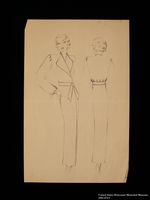
Coat design created by a German Jewish man and saved by his wife in hiding
Object
Original design for a coat created by Julius Isaacsohn, a Jewish designer with his own garment making business in prewar Berlin, Germany. In 1938, Julius and his wife Gertrud, a dressmaker with her own business, had lost their livelihood because of the anti-Semitic policies of the Nazi regime. They sent their daughter Dorit, age 6, to Brussels, Belgium, in early 1939, to stay with Gertrud’s sister Anna Kaufman. Germany invaded Belgium in May 1940, and Gertrud and Julius had Dorit returned to them in 1941. Gertrud and Julius became forced laborers for the German government, working in a leather factory and lumber yard respectively. On February 27, 1943, the family had to separate in order to go into hiding. Julius and Dorit stayed with family friends and Julius’ nephew, Rolf Isaacsohn, in Berlin, while Gertrud began working as a traveling seamstress. In October 1943, Gertrud brought Dorit to live with her on a farm in Wilkersdorf. Shortly after, Julius, who was hiding with friends, was betrayed to the authorities by Rolf. On October 29, Julius was deported to Auschwitz-Birkenau killing center in German-occupied Poland, where he was killed. Gertrud and Dorit traveled around eastern Germany making dresses for private clients until January 1945, when they were liberated by Soviet forces in Wilkersdorf. Gertrud and Dorit immigrated to the United States in November 1949.
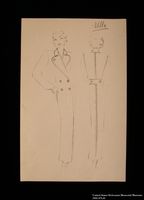
Coat design, Ulla, created by a German Jewish man and saved by his wife in hiding
Object
Original design for a coat created by Julius Isaacsohn, a Jewish designer with his own garment making business in prewar Berlin, Germany. In 1938, Julius and his wife Gertrud, a dressmaker with her own business, had lost their livelihood because of the anti-Semitic policies of the Nazi regime. They sent their daughter Dorit, age 6, to Brussels, Belgium, in early 1939, to stay with Gertrud’s sister Anna Kaufman. Germany invaded Belgium in May 1940, and Gertrud and Julius had Dorit returned to them in 1941. Gertrud and Julius became forced laborers for the German government, working in a leather factory and lumber yard respectively. On February 27, 1943, the family had to separate in order to go into hiding. Julius and Dorit stayed with family friends and Julius’ nephew, Rolf Isaacsohn, in Berlin, while Gertrud began working as a traveling seamstress. In October 1943, Gertrud brought Dorit to live with her on a farm in Wilkersdorf. Shortly after, Julius, who was hiding with friends, was betrayed to the authorities by Rolf. On October 29, Julius was deported to Auschwitz-Birkenau killing center in German-occupied Poland, where he was killed. Gertrud and Dorit traveled around eastern Germany making dresses for private clients until January 1945, when they were liberated by Soviet forces in Wilkersdorf. Gertrud and Dorit immigrated to the United States in November 1949.
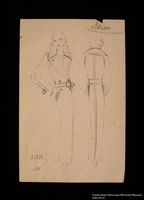
Coat design, Ibsen, created by a German Jewish man and saved by his wife in hiding
Object
Original design for a coat created by Julius Isaacsohn, a Jewish designer with his own garment making business in prewar Berlin, Germany. In 1938, Julius and his wife Gertrud, a dressmaker with her own business, had lost their livelihood because of the anti-Semitic policies of the Nazi regime. They sent their daughter Dorit, age 6, to Brussels, Belgium, in early 1939, to stay with Gertrud’s sister Anna Kaufman. Germany invaded Belgium in May 1940, and Gertrud and Julius had Dorit returned to them in 1941. Gertrud and Julius became forced laborers for the German government, working in a leather factory and lumber yard respectively. On February 27, 1943, the family had to separate in order to go into hiding. Julius and Dorit stayed with family friends and Julius’ nephew, Rolf Isaacsohn, in Berlin, while Gertrud began working as a traveling seamstress. In October 1943, Gertrud brought Dorit to live with her on a farm in Wilkersdorf. Shortly after, Julius, who was hiding with friends, was betrayed to the authorities by Rolf. On October 29, Julius was deported to Auschwitz-Birkenau killing center in German-occupied Poland, where he was killed. Gertrud and Dorit traveled around eastern Germany making dresses for private clients until January 1945, when they were liberated by Soviet forces in Wilkersdorf. Gertrud and Dorit immigrated to the United States in November 1949.
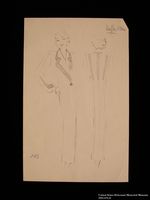
Coat design, Jaffa/ Ilse, created by a German Jewish man and saved by his wife in hiding
Object
Original design for a coat created by Julius Isaacsohn, a Jewish designer with his own garment making business in prewar Berlin, Germany. In 1938, Julius and his wife Gertrud, a dressmaker with her own business, had lost their livelihood because of the anti-Semitic policies of the Nazi regime. They sent their daughter Dorit, age 6, to Brussels, Belgium, in early 1939, to stay with Gertrud’s sister Anna Kaufman. Germany invaded Belgium in May 1940, and Gertrud and Julius had Dorit returned to them in 1941. Gertrud and Julius became forced laborers for the German government, working in a leather factory and lumber yard respectively. On February 27, 1943, the family had to separate in order to go into hiding. Julius and Dorit stayed with family friends and Julius’ nephew, Rolf Isaacsohn, in Berlin, while Gertrud began working as a traveling seamstress. In October 1943, Gertrud brought Dorit to live with her on a farm in Wilkersdorf. Shortly after, Julius, who was hiding with friends, was betrayed to the authorities by Rolf. On October 29, Julius was deported to Auschwitz-Birkenau killing center in German-occupied Poland, where he was killed. Gertrud and Dorit traveled around eastern Germany making dresses for private clients until January 1945, when they were liberated by Soviet forces in Wilkersdorf. Gertrud and Dorit immigrated to the United States in November 1949.
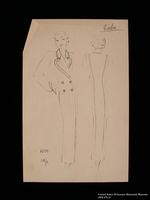
Coat design, Culm, created by a German Jewish man and saved by his wife in hiding
Object
Original design for a coat created by Julius Isaacsohn, a Jewish designer with his own garment making business in prewar Berlin, Germany. In 1938, Julius and his wife Gertrud, a dressmaker with her own business, had lost their livelihood because of the anti-Semitic policies of the Nazi regime. They sent their daughter Dorit, age 6, to Brussels, Belgium, in early 1939, to stay with Gertrud’s sister Anna Kaufman. Germany invaded Belgium in May 1940, and Gertrud and Julius had Dorit returned to them in 1941. Gertrud and Julius became forced laborers for the German government, working in a leather factory and lumber yard respectively. On February 27, 1943, the family had to separate in order to go into hiding. Julius and Dorit stayed with family friends and Julius’ nephew, Rolf Isaacsohn, in Berlin, while Gertrud began working as a traveling seamstress. In October 1943, Gertrud brought Dorit to live with her on a farm in Wilkersdorf. Shortly after, Julius, who was hiding with friends, was betrayed to the authorities by Rolf. On October 29, Julius was deported to Auschwitz-Birkenau killing center in German-occupied Poland, where he was killed. Gertrud and Dorit traveled around eastern Germany making dresses for private clients until January 1945, when they were liberated by Soviet forces in Wilkersdorf. Gertrud and Dorit immigrated to the United States in November 1949.
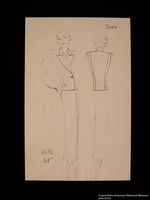
Jacket design, Gussi, created by a German Jewish man and saved by his wife in hiding
Object
Original design for a jacket created by Julius Isaacsohn, a Jewish designer with his own garment making business in prewar Berlin, Germany. In 1938, Julius and his wife Gertrud, a dressmaker with her own business, had lost their livelihood because of the anti-Semitic policies of the Nazi regime. They sent their daughter Dorit, age 6, to Brussels, Belgium, in early 1939, to stay with Gertrud’s sister Anna Kaufman. Germany invaded Belgium in May 1940, and Gertrud and Julius had Dorit returned to them in 1941. Gertrud and Julius became forced laborers for the German government, working in a leather factory and lumber yard respectively. On February 27, 1943, the family had to separate in order to go into hiding. Julius and Dorit stayed with family friends and Julius’ nephew, Rolf Isaacsohn, in Berlin, while Gertrud began working as a traveling seamstress. In October 1943, Gertrud brought Dorit to live with her on a farm in Wilkersdorf. Shortly after, Julius, who was hiding with friends, was betrayed to the authorities by Rolf. On October 29, Julius was deported to Auschwitz-Birkenau killing center in German-occupied Poland, where he was killed. Gertrud and Dorit traveled around eastern Germany making dresses for private clients until January 1945, when they were liberated by Soviet forces in Wilkersdorf. Gertrud and Dorit immigrated to the United States in November 1949.
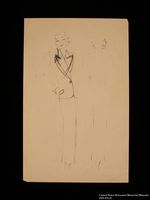
Unfinished jacket design created by a German Jewish man and saved by his wife in hiding
Object
Original, unfinished design for a jacket created by Julius Isaacsohn, a Jewish designer with his own garment making business in prewar Berlin, Germany. In 1938, Julius and his wife Gertrud, a dressmaker with her own business, had lost their livelihood because of the anti-Semitic policies of the Nazi regime. They sent their daughter Dorit, age 6, to Brussels, Belgium, in early 1939, to stay with Gertrud’s sister Anna Kaufman. Germany invaded Belgium in May 1940, and Gertrud and Julius had Dorit returned to them in 1941. Gertrud and Julius became forced laborers for the German government, working in a leather factory and lumber yard respectively. On February 27, 1943, the family had to separate in order to go into hiding. Julius and Dorit stayed with family friends and Julius’ nephew, Rolf Isaacsohn, in Berlin, while Gertrud began working as a traveling seamstress. In October 1943, Gertrud brought Dorit to live with her on a farm in Wilkersdorf. Shortly after, Julius, who was hiding with friends, was betrayed to the authorities by Rolf. On October 29, Julius was deported to Auschwitz-Birkenau killing center in German-occupied Poland, where he was killed. Gertrud and Dorit traveled around eastern Germany making dresses for private clients until January 1945, when they were liberated by Soviet forces in Wilkersdorf. Gertrud and Dorit immigrated to the United States in November 1949.
Coat design, Basel, created by a German Jewish man and saved by his wife in hiding
Object
Original design for a coat created by Julius Isaacsohn, a Jewish designer with his own garment making business in prewar Berlin, Germany. In 1938, Julius and his wife Gertrud, a dressmaker with her own business, had lost their livelihood because of the anti-Semitic policies of the Nazi regime. They sent their daughter Dorit, age 6, to Brussels, Belgium, in early 1939, to stay with Gertrud’s sister Anna Kaufman. Germany invaded Belgium in May 1940, and Gertrud and Julius had Dorit returned to them in 1941. Gertrud and Julius became forced laborers for the German government, working in a leather factory and lumber yard respectively. On February 27, 1943, the family had to separate in order to go into hiding. Julius and Dorit stayed with family friends and Julius’ nephew, Rolf Isaacsohn, in Berlin, while Gertrud began working as a traveling seamstress. In October 1943, Gertrud brought Dorit to live with her on a farm in Wilkersdorf. Shortly after, Julius, who was hiding with friends, was betrayed to the authorities by Rolf. On October 29, Julius was deported to Auschwitz-Birkenau killing center in German-occupied Poland, where he was killed. Gertrud and Dorit traveled around eastern Germany making dresses for private clients until January 1945, when they were liberated by Soviet forces in Wilkersdorf. Gertrud and Dorit immigrated to the United States in November 1949.
Coat design, Mia, created by a German Jewish man and saved by his wife in hiding
Object
Original design for a coat created by Julius Isaacsohn, a Jewish designer with his own garment making business in prewar Berlin, Germany. In 1938, Julius and his wife Gertrud, a dressmaker with her own business, had lost their livelihood because of the anti-Semitic policies of the Nazi regime. They sent their daughter Dorit, age 6, to Brussels, Belgium, in early 1939, to stay with Gertrud’s sister Anna Kaufman. Germany invaded Belgium in May 1940, and Gertrud and Julius had Dorit returned to them in 1941. Gertrud and Julius became forced laborers for the German government, working in a leather factory and lumber yard respectively. On February 27, 1943, the family had to separate in order to go into hiding. Julius and Dorit stayed with family friends and Julius’ nephew, Rolf Isaacsohn, in Berlin, while Gertrud began working as a traveling seamstress. In October 1943, Gertrud brought Dorit to live with her on a farm in Wilkersdorf. Shortly after, Julius, who was hiding with friends, was betrayed to the authorities by Rolf. On October 29, Julius was deported to Auschwitz-Birkenau killing center in German-occupied Poland, where he was killed. Gertrud and Dorit traveled around eastern Germany making dresses for private clients until January 1945, when they were liberated by Soviet forces in Wilkersdorf. Gertrud and Dorit immigrated to the United States in November 1949.

